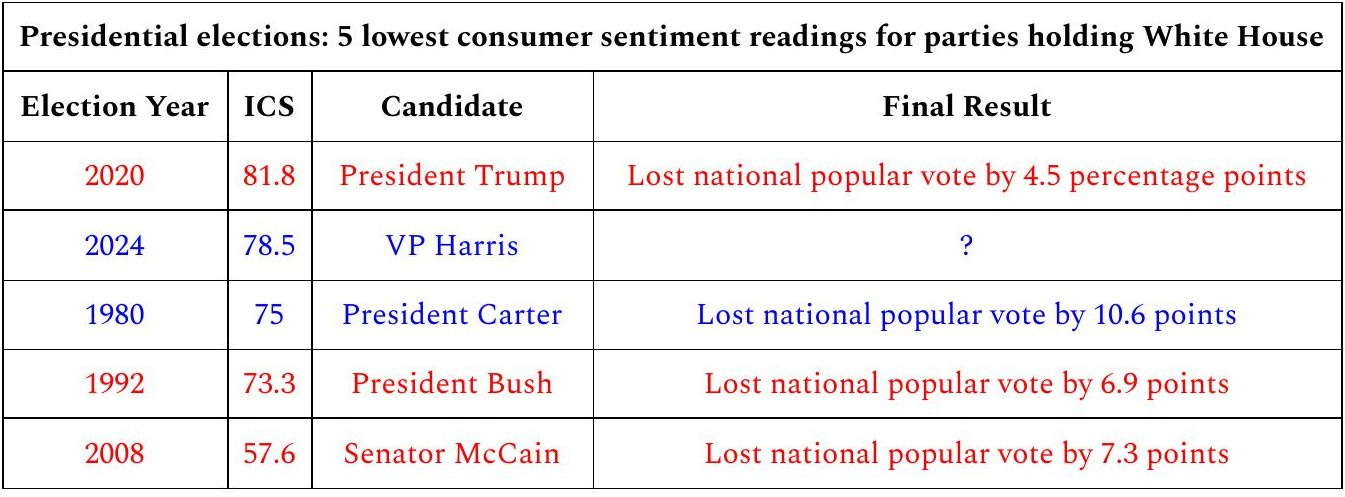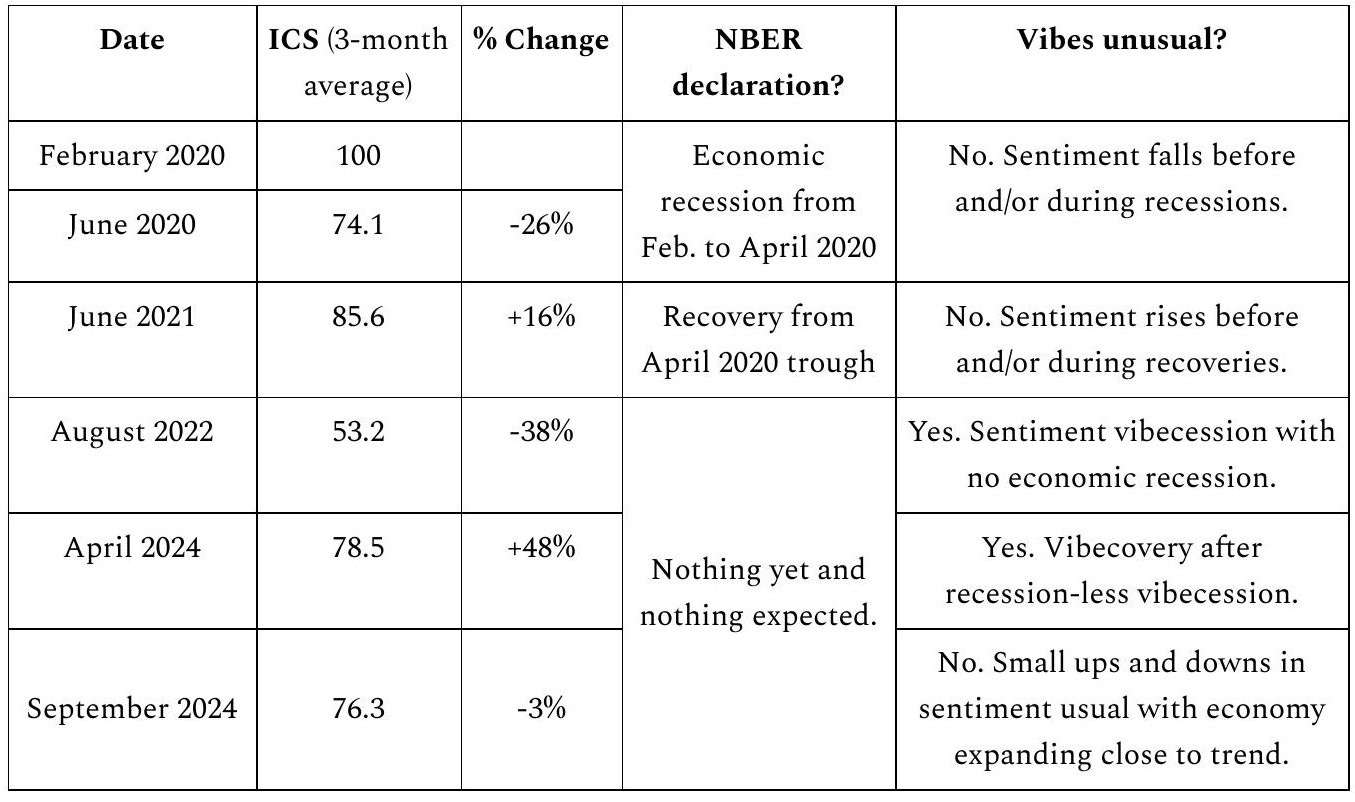Vibes uptick big enough for Harris?
Obama survived the 2011 vibecession to win in 2012. Can Harris do same in 2024?
Photo credit: Official portrait of President-elect Barack Obama; Pete Souza, photographer
Library of Congress Prints and Photographs Division Washington, D.C. 20540 USA http://hdl.loc.gov/loc.pnp/pp.print
Hot takes (some even evidence-based)
Trump still has a chance to win the state-by-state Electoral College.
The best thing Trump has going for his election chances is Americans’ continuing economic gloom after the 2021-22 vibecession.
Voters’ economic vibes have recovered, but consumer sentiment is still at a low enough level that the challenger candidate should normally defeat the incumbent.
Hope for Harris: Obama survived the 2011 vibecession to be re-elected in 2012.
Hope for Trump: Obama’s vibecovery brought sentiment back to a higher level before the 2012 election than the current vibecovery has reached so far in 2024.
Hope for Harris: it’s not the exploding hydrogen cars, stupid! Trump can’t seem to focus on exploiting voters’ economic angst.
Hope for Harris: better economic news in October may boost voter vibes.
Nate Silver: “the race is basically a toss-up”
Kamala Harris 51.2% vs. Donald Trump 48.8%
Source: Author’s calculation of average of decided vote in polls restricted to the 2 major candidates and reported by RealClear Polling with polling after 2024-9-15.
The silver lining for Donald Trump is that he can win the state-by-state Electoral College even if he loses the nation-wide popular vote. In 2016, Trump won the presidency despite trailing Hillary Clinton by just over 2 percentage points in the popular vote. Nate Silver estimates that Clinton needed a 3-point popular vote margin to win the Electoral College. In 2020, Trump just barely lost the Electoral College despite trailing in the popular vote by 4.5 points.
The silver lining for Harris is that the Democrats’ Electoral College disadvantage may be smaller in 2024 than in the past two presidential elections.
Silver’s “toss-up” analogy sums up the Electoral College race with 5 weeks left.
Professor Edsall’s take
In his latest NY Times column, journalism Professor Thomas Edsall asked:
“How is it possible that Donald Trump has a reasonable chance of winning the presidency despite all that voters now know about him? … His mendacity, duplicity, depravity, hypocrisy and venality”
It’s feelings about the economy, Professor
The one-word answer to Professor Edsall’s question is: “vibecession”.
In 2022, Kyla Scanlon originated the word “vibecession”, which she defines as:
“a disconnect between consumer sentiment and economic data”
To put some numbers around Scanlon’s qualitative concept, I define a vibecession to be a decline of 20% or more in the University of Michigan’s Index of Consumer Sentiment (ICS) when the National Bureau of Economic Research (NBER) does NOT declare a recession. In other words, a vibecession occurs when consumer sentiment plunges sharply – typically a leading indicator of an economic recession, but no recession follows.
What matters for presidential politics is the level of consumer sentiment just before the November election. ICS matters more than whether the party holding the White House has been in office during a recession. Fairly or not, the pre-election Index of Consumer Sentiment is akin to a report card from voters on how they feel about the economy and the incumbent administration’s economic management.
The University of Michigan reported a final estimate for September ICS. Even after my adjustment rendering September ICS under UMichigan’s new survey methodology comparable to ICS data before the April 2024 survey change, we can see in the following table that no party holding the White House has won a presidential election with sentiment as low as ICS is now.
Sources: Monthly ICS (= Index of Consumer Sentiment) in October just before each November election except for preliminary reading for September 2024. Author’s calculation of incumbent party shares of the 2-party vote, which is a better measure than incumbent party share of total votes including minor parties.
The following table traces the evolution of the economic bad vibes haunting Kamala Harris’ campaign. Consumer sentiment fell to an all-time low during the 2021-22 vibecession even though there was no economic recession in those years. After hitting bottom in the summer of 2022, sentiment recovered – what I call a vibecovery after a no-recession vibecession. But, the vibecovery paused in early 2024. September ICS is down 3% since the spring of 2024 — down to a relatively low level at which no incumbent party has ever been able to keep the White House.
Dear Professor Edsall: Trump still has a chance to win because the vibecession was so deep in 2021-22. The subsequent vibecovery has not been strong enough to lift voters’ economic vibes back to a level needed for Harris to be sure of beating Trump.
Obama beat vibecession: Harris hopes “Yes, she can” too
History never repeats exactly, but sometimes it’s reassuring to look back anyway.
As you can see in the following table, 2021-22 was not the first vibecession. Just as the 2021–22 vibecession put Democrats in a hole leading up to the 2024 vote, the 2011 vibecession threatened Barack Obama’s re-election prospects.
There are many similarities between the 2011 and 2021-22 vibecessions:
Both were preceded by severe recessions and then economic recoveries.
In both cases, the recoveries paused without slipping back to recession.
The vibecessions – falling consumer sentiment – overlapped with these growth slowdowns after initial post-recession bursts of rapid sentiment recovery. Neither vibecession was a mass delusion. Americans turned pessimistic when they feared a weak economic recovery might slip back into recession.
Both no-recession vibecessions were followed by sentiment vibecoveries.
Both vibecoveries paused during presidential election years. In summer 2012, ICS fell -9% in 2 months vs. -8% drop over 2 months in the spring of 2024.
Obama’s 2012 re-election followed a 14% ICS rebound from July to October 2012. Obama was a good candidate. Perhaps his ability as a campaigner helped to pump up consumer sentiment. But, he also benefited from good economic news in the autumn of 2012. Unemployment was the big issue after the 2007-2009 recession. In early October 2012, Americans heard the news that unemployment had fallen below 8% for the first time in almost 4 years. And, one month later on the Friday before election day, the unemployment rate remained stable at 7.8%.
On the 6th of November 2012, Obama won the national popular vote by 4 percentage points and the Electoral College by 332 to 206.
It’s NOT the exploding hydrogen cars, stupid
Consumer sentiment has also bounced off its low for the year in 2024. But, the 8% bounce-back so far this year is smaller than in 2012. ICS remains at a below-average level at which no incumbent party has ever kept the White House.
With Americans’ economic discontent still simmering, the Republican candidate for president should be well ahead of Vice President Kamala Harris in all polls. That Harris even has a chance speaks to what a bad candidate Donald Trump is.
Trump delivered a much-heralded economic policy speech in Savannah, Georgia on September 24th. In a 80-minute address, Trump put forward proposals that the majority of voters would support:
“We will put a 100 percent tariff on every single car coming across the Mexican border.”
“Under my plan, we will cut energy and electricity prices in half within 12 months. That means for your homes too.”
“starting on day one, we will end inflation”
“no tax on tips, no tax on overtime… No tax on social security.”
I make no comment on whether the Trump plan would work as advertised. But, as a matter of pure politics, Trump’s promises should make his populism more popular.
If Trump stuck to a message about fixing Americans’ perceived economic ills over the rest of the campaign, voters might be receptive. But, Trump muddied his economic speech by harping on the following non-economic issues:
the perils of exploding hydrogen-fueled cars (99 sold in the USA in the 2nd quarter of 2024 with no reported explosions)
making fun of the Republican Mayor of Springfield, Ohio
“Trump mixes up the name of Charlottesville, Virginia, during his speech in Georgia” (Associated Press)
invincible Russia: “they beat Hitler, they beat Napoleon. That’s what they do, they fight and it’s not pleasant.” (To win the Electoral College, Trump likely needs one of Michigan, Pennsylvania or Wisconsin — all with large numbers of Polish-Americans unlikely to be impressed by his praise of Russia.)
Biden “in a bathing suit. You know when you’re 82, it’s never too pretty.”
President Biden sleeps too much: “I find it very hard to sleep. I get so many ideas. I’m thinking all the time.”
While thinking big ideas instead of sleeping, Trump still found time to end his economic policy day in the must-win state of Georgia by posting after midnight:
“A great day in Louisiana!”
What’s next for feelings about the economy?
I still think that consumer sentiment – how Americans feel about the economy – will play an important role during the rest of the campaign.
The University of Michigan will release a preliminary estimate of the Index of Consumer Sentiment (ICS) for October on Friday the 11th and a final estimate on Friday the 25th. If ICS (adjusted for the April 2024 change in survey method) rises for a 5th consecutive month, that will be a good sign for Harris.
I’m not expecting Trump to sleep better next month and up his campaigning game enough to influence voters’ feelings about the economy.
Harris is largely preaching to the converted at this late stage. But, for swing voters and lukewarm Harris-leaners, who may or may not turn out to vote, the Vice President is trying at least to deliver a message that better economic days are ahead.
Economic news could still affect voters’ feelings about the economy. Inflation is the top economic issue in this campaign. On Thursday the 10th, the Census Bureau will update annual inflation. The Cleveland Fed is nowcasting that inflation will fall again possibly to as low as 2.2% for the year to September from the current rate of 2.5%.
That would be a small drop compared to some of the rapid declines since inflation peaked at 9.1% in June 2022. But, for Harris even a small bit of good inflation news may alleviate some residual public anger about high inflation in 2021 and 2022.







